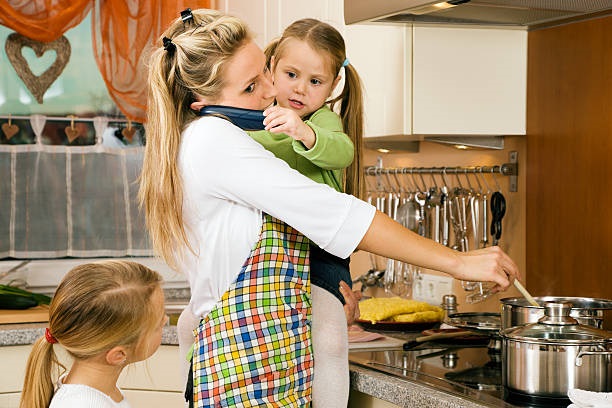Many people wonder: is a stay at home mom a dependent? The response is more complex than a simple yes or no. This depends on a number of factors, including financial agreements, family relationships, and tax legislation. We’ll go over everything in detail in this post so you can see why it matters and whether a stay at home mom is considered a dependent. For a more comprehensive understanding of this lifestyle, we’ll also look at related topics including what stay-at-home ladies do and how to be a conventional wife and mother.
- What Is a Dependent?
- Can a Stay at Home Mom Be Claimed as a Dependent?
- What Do Stay at Home Wives Do?
- How to Be a Traditional Wife and Mom
- Financial Considerations for Stay at Home Moms
- The Difference Between a Trad Wife and Stay at Home Mom
- Why This Matters
- FAQs About is a stay at home mom a dependent
What Is a Dependent?
Before diving into whether a stay-at-home mom qualifies as a dependent, it’s essential to understand what the term “dependent” means in legal and tax contexts. In most cases:
- A dependent is someone who relies on another person for financial support.
- Dependents are typically children, elderly parents, or individuals with disabilities.
- Tax benefits often apply to dependents, offering deductions or credits for their caregivers.
While stay at home moms provide valuable contributions to their families, their status as a dependent under tax laws depends on specific criteria.

Can a Stay at Home Mom Be Claimed as a Dependent?
Legally, a stay-at-home mom cannot be classified as a dependent for tax purposes if she is married. The IRS does not allow spouses to claim each other as dependents. However, here are some scenarios to consider:
1. Married Filing Jointly
- A stay-at-home mom filing taxes jointly with her spouse does not need to be listed as a dependent because both individuals are considered part of the same tax unit.
- The family may still qualify for other tax credits, such as the Child Tax Credit if they have children.
2. Filing as Head of Household
- If the stay at home mom is single or separated, she might qualify as a dependent under very specific circumstances, especially if she is financially reliant on another family member.
3. Qualifying Relative
- In rare cases, an adult may claim a stay at home mom as a dependent if she is unmarried, has no taxable income, and meets the IRS definition of a “qualifying relative.”
What Do Stay at Home Wives Do?

Stay-at-home moms and wives are the backbone of many households. They take on multiple roles, ensuring their families run smoothly. Here are some common tasks they handle:
- Household Management: Organizing finances, cleaning, and grocery shopping.
- Parenting Duties: Raising children, helping with homework, and managing extracurricular activities.
- Emotional Support: Providing a stable, loving environment for their families.
- Community Contributions: Volunteering or participating in social activities.
Understanding mom and wife stay at home responsibilities highlights how crucial their role is, even if it doesn’t translate into financial earnings.
How to Be a Traditional Wife and Mom

For those inspired by the traditional homemaker lifestyle, here’s how you can embrace the role:
Prioritize Your Family’s Needs:
Focus on nurturing and creating a peaceful home.
Develop Organizational Skills:
Efficiently manage household chores, appointments, and family schedules.
Practice Self-Care:
Taking care of yourself ensures you can better care for others.
Engage in Continuous Learning:
Hone skills like cooking, budgeting, or even homeschooling.
Maintain Strong Communication:
Build a solid partnership with your spouse to work as a team.
The concept of being a “traditional wife” ties closely to the discussion about the difference between a trad wife and stay-at-home mom, as the roles may overlap or differ depending on cultural and personal preferences.
Financial Considerations for Stay at Home Moms
While stay-at-home moms contribute immensely to their families, the financial implications must be carefully considered:
- Life Insurance: Consider a policy to account for the financial value of their role in the household.
- Savings Contributions: Stay-at-home moms can still contribute to retirement savings, such as a spousal IRA.
- Tax Credits: Explore tax breaks like the Child and Dependent Care Credit, which may indirectly benefit families.
By understanding these financial aspects, families can make informed decisions to support their stay-at-home mom effectively.
The Difference Between a Trad Wife and Stay at Home Mom

While both roles prioritize family, there are subtle differences:
- A traditional wife may embody specific cultural or religious values, emphasizing traditional gender roles.
- A stay at home mom, on the other hand, focuses on parenting and managing household tasks, often adapting to modern values.
Both roles are equally valuable, and the choice depends on individual preferences and family dynamics.
Why This Matters
Understanding is a stay at home mom a dependent is not just about taxes. It’s about valuing the unseen work that stay-at-home mothers and wives do. Your role influences the prosperity and well-being of your family, regardless of whether you consider yourself a modern stay-at-home mother or a conventional wife. You may make the greatest choices for your family with confidence if you investigate the sociological, emotional, and financial effects.
FAQs About is a stay at home mom a dependent
1. Can a stay-at-home mom be a dependent on taxes?
No, married stay-at-home moms cannot be claimed as dependents by their spouses. However, there may be other tax credits available for the family.
2. What is the financial value of a stay-at-home mom?
A stay-at-home mom’s contributions, like childcare and household management, can equate to a six-figure salary if measured in market terms.
3. What do stay-at-home wives do daily?
Their day may include cooking, cleaning, organizing schedules, raising children, and providing emotional support to their families.
4. Can a traditional wife work from home?
Yes, many traditional wives balance household duties with remote or part-time jobs to contribute financially.
5. How does a stay-at-home mom save on household expenses?
By managing budgets, cooking at home, and reducing childcare costs, they contribute to financial savings for the household.





